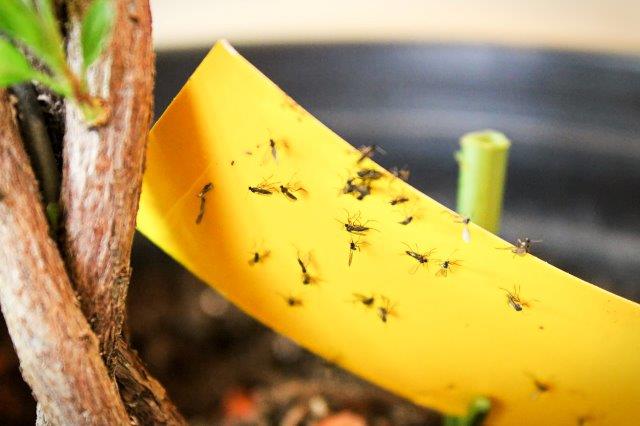Fungus gnats are unique to the garden because they do not feed on plants the same way as other insects and, as the name suggests, they prefer a diet of fungi, rot, and decomposition. Fungus gnats are found exclusively in potting soils in nearly any oversaturated, shaded grow space both indoors and out.
Fungus gnats are commonly known as “lawn gnats” because they are found in swarms hovering above lawns and grasses, due to the fact that they likely hatched right there in the lawn. Fungus gnats are more of a nuisance and annoyance to gardeners than an actual threat unlike more aggressive spider mites, mealybugs, and aphids.
Although adult fungus gnats don’t pose much threat, developing larvae and pupa beneath the soil have the potential to feed on root hairs and stems, potentially making the host plant susceptible to soil-borne pathogens.
How to Get Rid of Fungus Gnats
- Fungus Gnat Distribution: Greenhouses and excessively moist potting soil around the world
- Fungus Gnat Host Plants: Fungus gnats infest excessviely moist, shaded soils rather than plants
- Fungus Gnat Life Cycle: 7-10 days
- Fungus Gnat Eggs Per Lifetime: 100-150 eggs
- Fungus Gnat Control: Sticky traps, vinegar traps, petroleum jelly trap, hydrogen peroxide
- Fungus Gnat Predators: Nematodes, mites, thrips, aphids, leaf miners
- Most Common Fungus Gnats in North America: Common Fungus Gnat Bradysia spp.

What Do Fungus Gnats Look Like?
Fungus gnats can be tricky to properly identify because they have similar features to other common garden pests.
Understanding that fungus gnats exclusively live in soil can help differentiate a possible infestation from other insects. Fungus gnats are very tiny, similar to fruit flies, and are often mistaken for small mosquitoes because they have nearly the same exact body.
While mosquitoes big and small generally all share very light coloring such as white, silver, or iridescence, fungus gnats are almost universally dark or black similar to the common housefly. Although compared to both fruit flies and house flies, fungus gnats could never be confused for the two because they are much thinner in appearance, similar to thrips.
Fungus Gnat Damage
Unlike other pests found in the home garden, fungus gnats do not actually cause damage to plants or people, but are merely just a nuisance that most would prefer to not have buzzing around their home.
Fungus gnats are, at worst, annoying as they are notorious for pooling and dying around sunny windows when stuck indoors from having infested a saturated host of potting soil. Fungus gnats spawn in fertile soils and lawns and anyone who’s played baseball probably has some experience swatting at fungus gnats in left field.
Mushroom farms of any size are at risk for potential crop loss because fungus gnats specifically feed on fungi and decomposition.

What Do Fungus Gnats Eat?
Fungus gnats are unique garden pests when compared to others because they do not seek out host plants but, rather, host soils. As their name implies, fungus gnats feed on fungi, rot, and decaying plant matter within excessively moist potting soils, both indoors and out. Fungus gnat larvae are also known to lightly feed on root hairs and any portion of the plant buried beneath the soil including stems.
Although fungus gnats may feed on roots, the damage is often negligible unless the host plant contradicts a disease from the soil-borne pathogens. Fungus gnats are widespread in mushroom farms, feasting on fungi in the shaded, moist, and minimally ventilated environment.
Fungus Gnats Eggs

Fungus gnat eggs are rare to see because they are buried in the top ½” of soil away from the naked eye and only remain as an egg for 4-6 days until hatching into larva.
Fungus gnat eggs are a translucent pale yellow similar to roe if you are lucky enough to detect an early cluster of eggs on top of your potting soil.
To keep fungus gnat eggs from your indoor and outdoor soils, be sure to properly drain and dry the soil to keep inhospitable for a possible infestation.
Most home gardeners are more familiar with ridding their soils of the more developed fungus gnat pupa only because it is slightly easier to detect than the quickly-hatching nest of eggs.
How to Get Rid of Fungus Gnats
The most direct way to rid your potting soil of a fungus gnat infestation is to keep it properly drained and dried. The reason you have an infestation in the first place is because the soil, whether indoors or out, is excessively moist, shaded, and full of microscopic fungi.
Sticky insect and fly traps are popular to catch adult fungus gnats because each adult potentially could lay up to 150 eggs in their brief lifespan. For a DIY sticky trap, spread an even layer of petroleum jelly onto a bright yellow or orange disposable plate.
Another effective DIY option is to create a cider vinegar trap by adding equal parts warm water and cider vinegar to a shallow tray (tuna can) and add a few drops of dish soap.
Fungus Gnat Treatment

- Sticky Traps - Immediate treatment for fungus gnats
- Hydrogen Peroxide - 1 part 10% hydrogen peroxide to 4 parts water
- Fungus Gnats Vinegar - 1 part vinegar to 3 parts water
- Pyrethrin Spray - Natural chemical extract and pesticide from the genus Chrysanthemum
- Powdered Cinnamon - Lightly sprinkle onto affected soil as a powerful treatment
- Chamomile Tea - Simply brew a pot of chamomile tea and water soil once cooled
- Drying Out Soil - Houseplants can be left out in the sun to fully dehydrate soil




